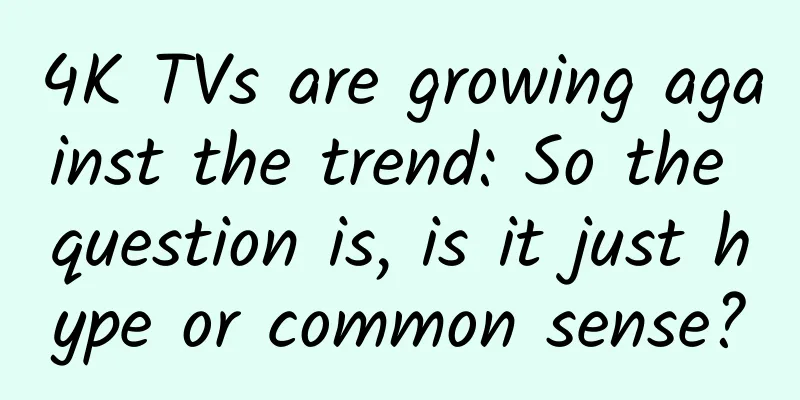4K TVs are growing against the trend: So the question is, is it just hype or common sense?

|
What exactly is a 4K TV? In a nutshell, a 4K TV is a TV with a 4K resolution. 4K resolution refers to a resolution of 4096×2160 pixels, which is four times the standard 1920×1080 resolution of 2K projectors and HDTVs. It is an ultra-high-definition resolution. At this resolution, viewers will be able to see every detail and every close-up of the picture. At first glance, the slogan of "four times the resolution of HDTV" is indeed very attractive, but if we analyze it carefully, is this so-called four times resolution really useful? In addition, does 4K TV, which has shortcomings in video resources, technical standards and cost-effectiveness, really have its own market value and application value? First of all, let’s look at the most prominent feature of 4K TV: ultra-high definition. As a technological innovation of flat-panel TVs in recent years, 4K ultra-high-definition display technology has indeed promoted the progress of the industry, but does this innovation match the current actual situation of the TV industry? At present, televisions in mainland China have not even fully achieved 1080p push. Most TV stations are still at 720p clarity. The resolution of the human eye is limited. On a 4K screen, the 720p picture quality will only appear more blurred and have more mosaics. Under such a reality, what is the point of launching 4K TVs? In fact, when 1080p was first introduced, few people really knew what it was. They just heard that 1080p was higher than 720p, so they naturally thought it was better. Now that 4K TVs that are higher than 1080p have appeared, there is a so-called counter-trend growth. Secondly, there is the problem of video content, or the so-called source of video. It is understood that there is no 4K TV channel in the world, and Japan, where 4K is most developed, will not have a commercial 4K channel until 2020. Domestic sources are even more scarce, and even the source information on the Internet is disorganized, and there are only a handful of people who want to use it. Even foreign websites list several existing ways to obtain 4K sources: buying a 4K camera, using a Blu-ray player, etc., but there is no explanation of how to use it, and no matter how much extra money is spent, it will be useless. The reason why consumers buy 4K TVs at high prices is that they hope to be able to watch more shocking and clear content. However, now there are no 4K sources for offline playback, and there is no TV station support when they want to watch TV. The sense of loss can be imagined. Of course, 4K TV is still in its early stages, which is understandable. After all, it took nearly a decade for HDTV to have enough content to watch now, and now it has suddenly turned to 4K TV. TV stations also need time to adjust broadband issues, program reserves, and photography tools. So, it doesn’t matter if you buy a 4K TV. It will take a few years at the fastest and ten years at the slowest to fulfill your current dream of watching ultra-high-definition TV. I’m just afraid that by then, new technologies such as 6K and 8K TVs will appear. Finally, although 4K TV has made a breakthrough in resolution, there is still no improvement in image quality. Compared with the advancement of surpassing the resolution of the human eye, the improvement in contrast, color accuracy and other aspects is more practical for consumers' visual experience, but these contents have not been well valued, although this is related to the current technical limitations. Therefore, the greater significance of 4K TV lies in its technological innovation that breaks through the current resolution. As the technical level rises, the production threshold also drops. TV manufacturers can create more high-tech products similar to 4K TV in minutes. Of course, this has become a promotional point for them to stimulate sales, and some consumers who are confused about the facts are rushing to pay for it. It is undeniable that 4K TV is a technological advancement in the TV industry and a future market trend, but for the current market, it is still just a concept, and the so-called counter-trend growth is just a fleeting false fire. Any product that is not cost-effective and does not meet the immediate needs of consumers is a hooligan. As a winner of Toutiao's Qingyun Plan and Baijiahao's Bai+ Plan, the 2019 Baidu Digital Author of the Year, the Baijiahao's Most Popular Author in the Technology Field, the 2019 Sogou Technology and Culture Author, and the 2021 Baijiahao Quarterly Influential Creator, he has won many awards, including the 2013 Sohu Best Industry Media Person, the 2015 China New Media Entrepreneurship Competition Beijing Third Place, the 2015 Guangmang Experience Award, the 2015 China New Media Entrepreneurship Competition Finals Third Place, and the 2018 Baidu Dynamic Annual Powerful Celebrity. |
<<: iPhone 6 parallel import prices cut in half, scalpers left in tears
Recommend
How much does it cost to customize the cosmetics mini program in Zhongshan? Zhongshan cosmetics mini program customized price inquiry
What is the price for customizing the cosmetics m...
The past and present of "Sanfutie"
Author: Yang Yingzhan, Institute of Chinese Mater...
Liu Heng's I Ching: Lectures on Physiognomy
Liu Heng's Physiognomy Lecture Room Resource ...
Download the full set of 2020 Suntech Financial Management Course videos
Download the full set of 2020 Suntech Financial M...
How to plan a successful fission marketing process design?
Fission marketing is actually somewhat similar to...
iOS apps are banned from being "free" and Apple did not explain why
Now, if the word "free" appears in the n...
The most searched topic! Why is the ubiquitous morning glory a banned ingredient in cosmetics?
Review expert: Wang Kang, Director of the Science...
EVCIPA: Operation of electric vehicle charging and swapping infrastructure in January 2025
In January 2025, there were 181,000 more public c...
How did those animals with the word "king" in their names become kings?
In nature, some animals are "crowned kings&q...
The frozen crocodile I bought back home came back to life? Is it really not illegal to eat crocodiles?
Recently, a short video went viral on the Interne...
E-commerce promotion: Only by doing this in daily promotion can you "defeat the enemy"
During shopping carnivals such as Double Eleven a...
NetQin strategically restructures the mobile entertainment show scene to create "new anchor stars"
"Internet +" has brought endless imagin...
When the river meets the ocean: an amazing estuary adventure
All rivers flow into the sea, which not only refe...
E-commerce operation copywriting skills, how to improve product selling points?
For the current e-commerce platforms such as Tmal...
Stock Broker Training Camp: Only Know How to Trade Stocks Episode 18
Stock Brother Training Camp: Only Know How to Tra...









